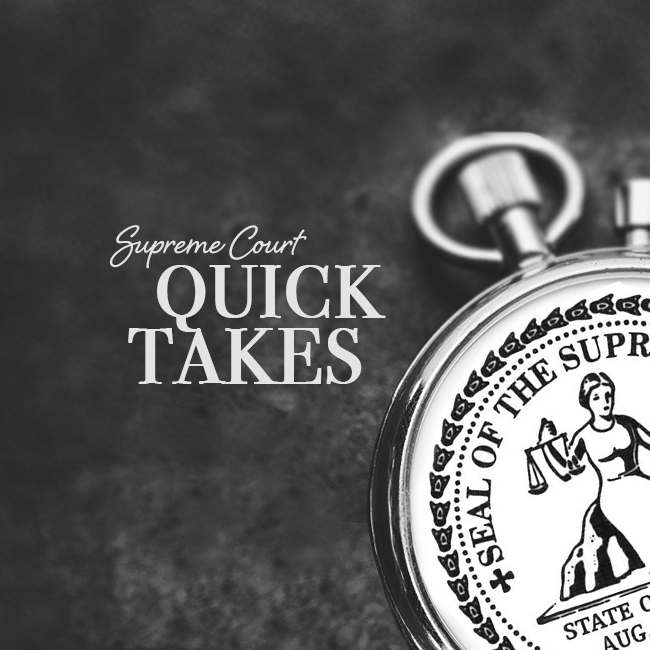Quick Take on Illinois Supreme Court Opinion Issued Thursday, August 22, 2024

A leading appellate attorney reviews the Illinois Supreme Court opinion handed down Thursday, August 22.
People v. Flournoy, 2024 IL 129353
By Kerry J. Bryson, Office of the State Appellate Defender
Johnny Flournoy was convicted of the 1991 murder of Samuel Harlib and the armed robbery of Harlib’s used car dealership. No physical evidence connected Flournoy to the offenses. The primary evidence against Flournoy consisted of an eyewitness identification by one of Harlib’s employees and the testimony of a man named Ramano Ricks, who claimed that he knew Flournoy and that Flournoy had admitted committing the offense with a mutual acquaintance. Flournoy appealed, and his convictions were affirmed. He also sought relief via an initial post-conviction, but was unsuccessful.
The instant appeal arose out of the denial of Flournoy’s motion for leave to file a successive post-conviction petition. In his proposed petition, Flournoy argued that he had newly discovered evidence of actual innocence in the form of affidavits from Ricks and from a woman named Elizabeth Barrier. He also asserted due process violations and a claim of ineffective assistance of counsel, and argued that Ricks’s and Barrier’s affidavits supported those claims, as well. The circuit court denied leave to file, and Flournoy appealed.
The appellate court affirmed. The court found that Flournoy had failed to present a colorable claim of actual innocence, failed to establish the requisite cause to raise one of his due process claims in a successive petition, and failed to make a prima facie showing to establish his ineffective assistance claim. As to a second due process claim, grounded in an allegation that the State knowingly presented perjured testimony by Ricks, the appellate court found that Flournoy was procedurally barred from relying on Ricks’s affidavit to support that claim because he had argued that the affidavit supported his actual innocence claim. More specifically, the appellate court held that under People v. Hobley, 182 Ill. 2d 404 (1998), a post-conviction petitioner cannot raise both a freestanding claim of actual innocence based on newly discovered evidence and then use that same evidence to also support an independent claim of a constitutional violation.
The primary question before the supreme court, then, was whether a petitioner seeking leave to file a successive post-conviction petition can use the same evidence to support both a claim of actual innocence and a claim of constitutional trial error. In its decision here, the court clarified that a petitioner can use the same evidence to plead both types of claims – actual innocence and constitutional trial error – but if the evidence ultimately establishes a claim of constitutional trial error, it cannot also establish a freestanding claim of innocence. That is because claims of trial error necessarily rest on the assumption that the supporting evidence was available to the parties at the time of trial, while an actual innocence claim rests on the opposite assumption, that the evidence was unavailable to the parties at trial, i.e., that it was newly discovered.
Ultimately, however, the court went on to affirm the denial of leave to file Flournoy’s successive petition. As to his claim of actual innocence, the court found that the supporting evidence was not newly discovered. The trial record demonstrated that Barrier was known to the parties before trial. Her name appeared in police reports, and defendant claimed to have spoken to her and decided not to call her as a witness. Regardless, even if counsel hadn’t spoken to Barrier, the court found that the evidence in her affidavit was discoverable prior to trial. And, Ricks was obviously known to defendant because he testified at trial, albeit in a manner that conflicted with the information in his affidavit. But, the court found that the evidence in Ricks’s affidavit was discoverable at the time of trial where the record contained evidence that Flournoy had conversations with Ricks before trial and that Ricks had made recantation statements during those conversations, in the presence of others. Accordingly, the court found Ricks’s recantation evidence not newly discovered.
As to Flournoy’s due process claims, the court found them barred by res judicata. He raised essentially the same claims in his previous post-conviction petition, as well as in his post-trial motion. Similarly, Flournoy had previously asserted ineffective assistance of counsel based on the failure to call Barrier to testify and thus could not now raise that same claim in a successive post-conviction petition. As to each of these claims, Flournoy argued that Ricks’s and Barrier’s affidavits provided him with previously-unavailable evidence to support those claims. But, as it had with regard to the claim of actual innocence, the court concluded that the evidence in question was discoverable at the time of Flournoy’s trial and thus could not now be used to relitigate claims that had already been raised and rejected.

